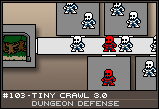| Three Hundred |
| - Index Page |
| - About... |
| - By Year |
| Collections |
| - Comp-Grid |
| - Procedural |
| - Tactics |
| - Tiny Crawl |
| - Misc |
| Previous | Mechanic #103 | Next |
The Tower Defense genre is one that is lost on me. I have no idea why they are so popular, frankly. Wave after wave of generic enemy goes down a set path upon which defensive structures are liberally place - it's kind of a one trick pony in my opinion. It's ironic because one of my previous ideas [#017 - Composition Army] has actually found life in TWO tower defense games (Plants Versus Zombies and Crystal Defenders: Vanguard Storm). This entry is my attempt at creating a tower defense game, or at least a cousin of a tower defense game. I'm going to use [#101 - Tiny Crawl 3.0 - Linear Dungeons] as my starting point.
|
![[defense1.png]](set06/img/entry103-defense1.png)
The basic premise is similar to all Tower Defense games. You have wave after wave of enemies go through a gauntlet and attempt to reach the goal at the end. Success yields money which you can use to build more defenses and improve you tech tree to provide even more powerful defenses. In this case, the gauntlet is a dungeon and you are attempted to kill groups of heroes before they can get to the end and defeat the final boss. How this differs is that rather than fighting an endless wave of generic enemies, you instead fight highly specialized parties of heroes - one party at a time. The enter from the dungeon entrance and then walk towards the boss at the very end. As the heroes encounter groups of enemies in the hallway, they battle them, as laid out in the [#101 - Tiny Crawl 3.0 - Linear Dungeons] entry. The way you populate a dungeon is by building rooms off the hallway (or in a more complex dungeon, off each hallway) where space allows. These rooms do two things: they build units, and they keep a queue of units waiting to go out into the hallway. With building units, they simply spawn a new unit of a specific type every X seconds, assuming the room is not full already. The rate is dependent on the room and enemy type. For instance, a slime room may generate a slime every two seconds and hold four enemies in the room - so it'll fill up with slimes in eight seconds, while a skeleton room may build one every thirty seconds and hold six enemies in the room. Though rooms generate bad guys, they do not have to stay in the room. You can drag and drop enemies from one queue to another, with the exception of the next enemy out the gate. So a slime room can make a slime (if there is space in the room for another enemy), then the player can drag the new slime over to a different room and insert it anywhere in the queue except for first in line. |
![[defense2.png]](set06/img/entry103-defense2.png)
The way a queue works is a single enemy leaves the room at a time, standing in front of the door. When that enemy is defeated, vacating that spot, the next in line from the room will drop down - assuming the heroes haven't already advanced in front of the door. In the above example, the hero team defeats the white skeleton with a barrage of arrows, causing the red skeleton to "drop" down to replace it. However, when they kill the slime, they move forward into its space, preventing the next slime from dropping down. After defeating the red skeleton and moving into it's spot, then the slime door will be open again and a slime can drop down and attack the enemy from behind. Enemies that are within one space of each other are considered to be grouped in combat. This means that for every turn the heroes make (warrior attacks, then archer fires bow), the enemy group gets a turn too. If an enemy is too far away, it is not in battle. At most, the heroes will be engaging in a single group in front of them, and potentially a single group behind them. The game occurs in waves of hero teams coming through, with a brief respite between each wave in which the player can rearrange queues and build/upgrade rooms - possibly buy traps to add to hallway squares which don't feature doorways. Basically, this is a game of planning ahead. Once the wave starts, you don't have any control over what happens. Instead, you line up all your enemies into a proper queue, hoping to pair compatible enemies and create specific combos that will decimate the enemy force (i.e. putting a slime that is easy defeated, then a heavy enemy which will drop behind the hero team and attack their weak flank). Since a wave may consist of multiple teams of heroes, you need to plan ahead and use the multitude of rooms and available enemies to create an impenetrable fortress.
|
